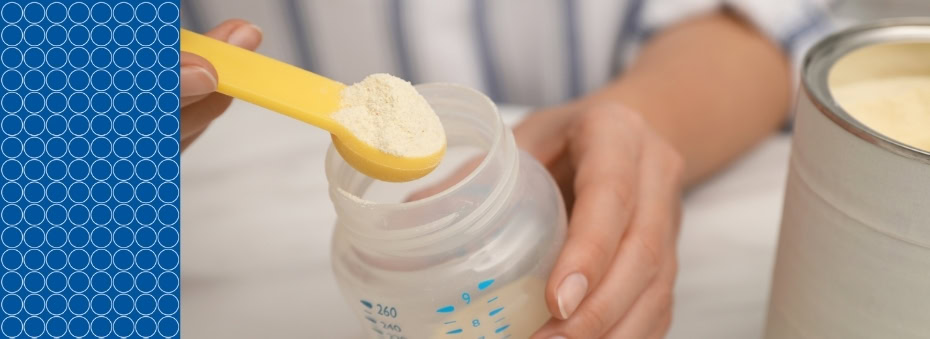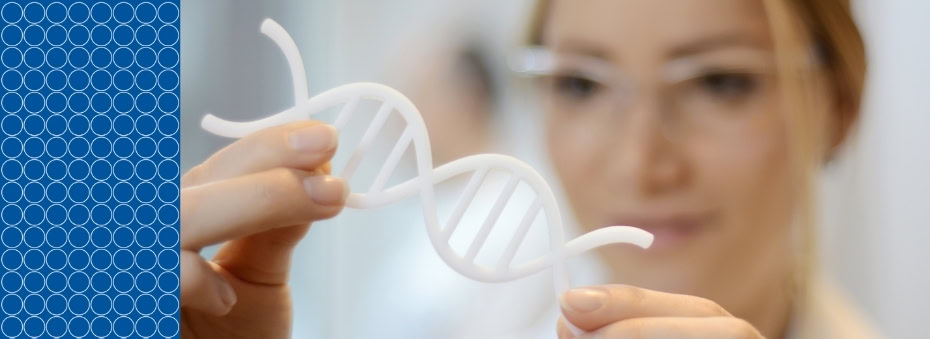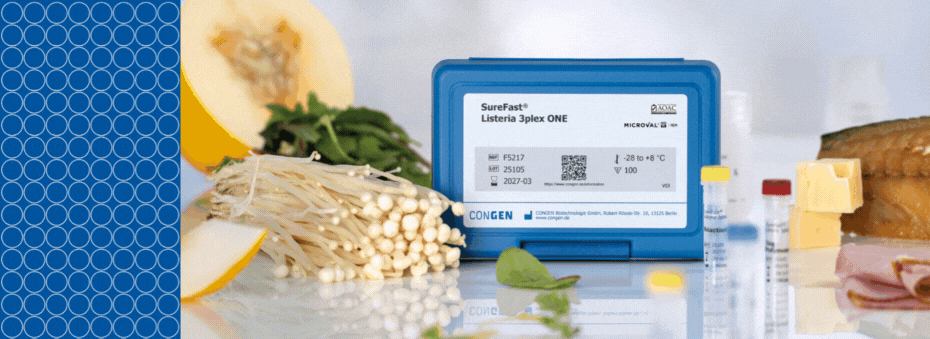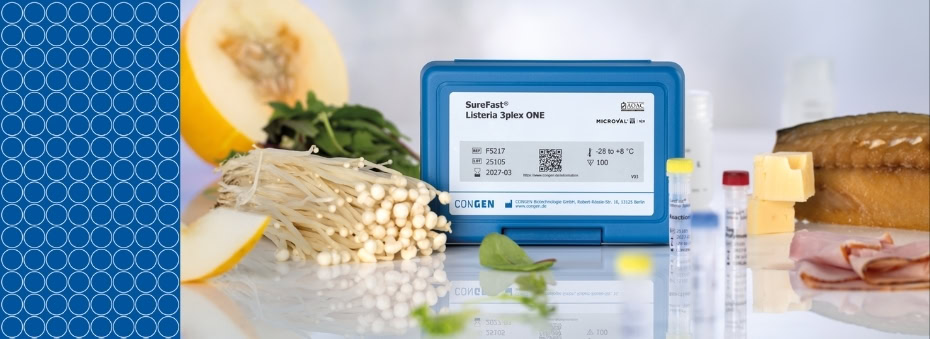
Batteri patogeni
Rilevazione di patogeni in grado di causare intossicazioni alimentari
- Home
- /
- Analiti
- /
- Microbiologia
- /
- Batteri patogeni
Batteri patogeni
Il cibo contaminato da batteri patogeni può causare gravi rischi per la salute dei consumatori. È quindi fondamentale controllare la presenza di patogeni durante tutte le fasi della produzione.
I batteri patogeni possono causare gravi intossicazioni alimentari e devono quindi risultare completamente assenti, o presenti entro specifiche quantità per grammo, negli alimenti. Le fonti più comuni di infezioni batteriche sono la frutti non trattata, gli ortaggi, i prodotti a base di carne e latte crudi e l’acqua. Garantire assoluta sicurezza alimentare è dunque una sfida molto complessa per tutte le parti interessate, soprattutto per chi si occupa dei controlli di qualità nei siti di produzione primari e nei grandi punti vendita e per le autorità governative.
La campilobatteriosi, al pari della salmonellosi, è una delle malattie diarroiche più diffuse al mondo. L’aumento dei casi di enterite da Campylobacter è reso ancora più rapido dalla diffusione del batterio in numerose specie di animali selvatici, da allevamento e da compagnia (uccelli e mammiferi). Essendo parte della flora batterica del pollame, Campylobacter trova facilmente modo di entrare a contatto con gli esseri umani. Altre forme di trasmissione per questo patogeno sono il latte, la carne trita e l’acqua. Campylobacter viene rilasciato in grandi quantità nell’ambiente da portatori di ogni genere ed entra a contatto con il corpo umano tramite cibi contaminati. La dose infettiva per l’enterite da Campylobacter è relativamente bassa; per scatenare un’infezione sono richiesti infatti meno di 500 batteri. Delle 15 specie note di Campylobacter, le due maggiormente responsabili di gastroenteriti negli esseri umani sono C. jejunie C. coli.
Il genere Clostridium è composto da batteri sporigeni gram-positivi, diffusi pressoché dappertutto nell’ambiente. Clostridium botulinum, Clostridium perfringens e Clostridium estertheticum sono patogeni di grande importanza. La contaminazione, causa a sua volta di gravi malattie, può avvenire se il cibo non viene raffreddato a sufficienza. Questi batteri sono termoresistenti e possono quindi sopravvivere anche negli alimenti riscaldati.
Legionella è un genere di batteri gram-negativi a bastoncino presenti negli ambienti acquatici e considerati dei potenziali patogeni. La specie maggiormente responsabile di malattie negli esseri umani è Legionella pneumophila, causa della malattia nota come legionellosi. Questa malattia si trasmette principalmente tramite il consumo di acqua contaminata.
I batteri del genere Listeria sono presenti pressoché dappertutto in natura. È possibile calcolare il rischio di contaminazione grazie a tecniche di rilevazione quantitativa. In particolare, Listeria monocytogenes è considerato una delle cause più comuni di intossicazioni alimentari e può provocare setticemia, meningite ed encefalite.
Il genere Salmonella è considerato tra le cause principali di intossicazioni alimentari al mondo. L’OMS calcola che si verifichino oltre 16 milioni di infezioni all’anno, più di mezzo milione delle quali fatali. Salmonella è presente principalmente nei cibi crudi quali uova, carne e latte. Il potenziale di rischio è molto elevato, soprattutto negli alimenti che non richiedono di essere riscaldati (per es. formaggio di latte crudo, insaccati crudi, cioccolato e gelato). Negli allevamenti industriali moderni la contaminazione da Salmonellarisulta pressoché inevitabile; è quindi fondamentale garantire un controllo di qualità efficace mediante test affidabili. A questo scopo offriamo una vasta gamma di test per il controllo delle condizioni igieniche delle superfici e degli alimenti.
Al microscopio, Staphylococcus aureus si presenta come un grappolo di batteri immobili di forma sferica, dal diametro compreso tra 0,8 e 1,2 µm e gram-positivi. S. aureus è un commensale degli esseri umani, presente principalmente sulla pelle e nelle vie respiratorie superiori, normalmente non portatore di malattie. Nei soggetti immunocompromessi o nel caso di infezioni da parte di ceppi patogeni, S. aureus può causare infezioni cutanee, ascessi e perfino malattie potenzialmente letali come polmonite, meningite, endocardite e sindrome da shock tossico (TSS).
Una delle ragioni della patogenicità di S. aureus risiede nella sua capacità di produrre enterotossine (SET), che si accumulano negli alimenti contaminati e non vengono disattivate completamente dal calore. Le contaminazioni da S. aureus negli alimenti sono causate quasi unicamente dall’interazione umana (mani, starnuti e colpi di tosse). S. aureus è quindi considerato indicatore di cattiva igiene personale.
S. aureus è di grande rilevanza anche per l’igiene delle strutture ospedaliere, in particolare quei ceppi che hanno sviluppato resistenza agli antibiotici comuni (cosiddetti “Staphylococcus aureus resistenti alla meticillina”, o MRSA) costituiscono un rischio di entità difficilmente valutabile, in quanto resistenti ai trattamenti più diffusi.
I batteri Escherichia coli (abbreviato solitamente in E. coli) fanno parte della flora intestinale umana e animale e sono solitamente innocui. Ne esistono però ceppi patogeni in grado di causare infezioni anche gravi. Uno di questi ceppi è noto come Escherichia coli enteroemorragica (EHEC). I ceppi patogeni prendono il nome dalle sostanze tossiche che producono: verotossina (VTEC) e tossina di Shiga (STEC). Le infezioni da STEC e VTEC sono tra le malattie di origine alimentare più diffuse e possono risultare anche fatali. Le fonti più comuni di contaminazione sono le carne crude e i prodotti lattiero-caseari non pastorizzati.
I vibrioni sono un genere di microorganismi patogeni che contaminano il cibo e possono causare infezioni anche gravi. I vibrioni presenti nei prodotti ittici sono una delle cause più diffuse di gastroenteriti, infezioni e setticemie. Alcune specie di vibrione possono causare infezioni estremamente contagiose come il colera.
Il batterio Vibrio parahaemolyticus è presente naturalmente nelle acque costiere, in particolare durante i mesi estivi. È una specie cosiddetta alofila, ovvero adattata agli ambienti ad elevata salinità; in quanto tale è particolarmente diffusa negli ambienti marini e nei prodotti ittici e in grado di causare gastroenteriti acute, come riscontrabile dalla sua presenza nelle feci dei soggetti colpiti.
Product portfolio
| Product | Descrizione | No. of tests/amount | Art. No. |
|---|---|---|---|
| RIDASCREEN® SET Total (96 tests) |
RIDASCREEN® SET Total is a sandwich enzyme immunoassay for the combined detection of Staphylococcus aureus enterotoxins A, B, C, D and E in fluid and solid foods as well as in bacterial cultures. Continua a leggere |
Microtiter plate with 96 wells (12 strips with 8 breakable wells each), 96 determinations. |
R4105 |
| RIDASCREEN® SET A,B,C,D,E |
RIDASCREEN® SET A,B,C,D,E is a sandwich enzyme immunoassay for the identification of Staphylococcus enterotoxins A, B, C, D and E in fluid and solid foods as well as in bacterial cultures. Based on its sensitivity the RIDASCREEN® SET A,B,C,D,E test … Continua a leggere |
Microtiter plate with 96 wells (12 strips with 8 wells each), one strip is necessary for analysis of one sample, 12 tests in total. |
R4101 |
| Product | Descrizione | No. of tests/amount | Art. No. |
|---|---|---|---|
| Compact Dry LM |
Usage of Compact Dry LM is a simple and safe test procedure for detection of Listeria monocytogenes in pre-enriched samples of foods. The ready-to-use plates consist of a special 50 mm diameter petri dish containing a detection specific nutrient pad. … Continua a leggere |
100 nutrient plates | HS9901 |
| Compact Dry PA |
Compact Dry PA is a simple and safe test procedure for the determination and quantification of Pseudomonas aeruginosa counts in foods, cosmetics, water samples or pharmaceutical materials. The ready-to-use plates consist of a special 50 mm diameter … Continua a leggere |
100 nutrient plates | HS9491 |
| Compact Dry BC |
Usage of Compact Dry BC is a simple and safe test procedure for determination and quantification of Bacillus cereus in foods or raw materials. The ready-to-use plates consist of a special 50 mm diameter petri dish containing a detection specific … Continua a leggere |
100 nutrient plates | HS9721 |
| Compact Dry X-SA |
Usage of Compact Dry X-SA is a simple and safe test procedure for determination and quantification of Staphylococcus aureus in foods, cosmetics or raw materials – as well as pharmaceutical raw materials. The ready-to-use plates consist of a special … Continua a leggere |
100 nutrient plates | HS9621 |
| Compact Dry VP |
Usage of Compact Dry VP is a simple and safe test procedure for detection and quantification of Vibrio parahaemolyticus as well as Vibrio spp. in foods or raw materials. The ready-to-use plates consist of a special 50 mm diameter petri dish … Continua a leggere |
100 nutrient plates | HS8821 |
| Compact Dry SL |
Usage of Compact Dry SL is a simple and safe test procedure for detection of Salmonella in pre-enriched samples of foods or raw materials. The ready-to-use plates consist of a special 50 mm diameter petri dish containing a detection specific nutrient … Continua a leggere |
100 nutrient plates | HS9401 |
| Compact Dry LS |
Usage of Compact Dry LS is a simple and safe test procedure for quantification of Listeria contaminations in foods or raw materials – as well as pharmaceutical raw materials. The ready-to-use plates consist of a special 50 mm diameter petri dish … Continua a leggere |
100 nutrient plates | HS8811 |
| Compact Dry EC |
Usage of Compact Dry EC is a simple and safe test procedure for determination and quantification of coliform bacteria and E. coli in foods, cosmetics, water or raw materials – as well as pharmaceutical raw materials. The ready-to-use plates consist … Continua a leggere |
100 nutrient plates | HS8781 |
| Compact Dry CF |
Usage of Compact Dry CF is a simple and safe test procedure for determination and quantification of coliform bacteria in foods, cosmetics or raw materials – as well as pharmaceutical raw materials. The ready-to-use plates consist of a special 50 mm … Continua a leggere |
100 nutrient plates | HS8791 |
| Product | Descrizione | No. of tests/amount | Art. No. |
|---|---|---|---|
| SureFast® Enterobacteriaceae 4plex |
The SureFast® Enterobacteriaceae 4plex is a multiplex real-time PCR for the direct, qualitative detection and differentiation of specific DNA sequences of Enterobacteriaceae, Cronobacter spp. and Salmonella spp.. Continua a leggere |
100 reactions | F5180 |
| SureFast® Fecal Screen 4plex |
The SureFast® Fecal Screen 4plex is a multiplex real-time PCR for the direct, qualitative detection and differentiation of specific DNA sequences of Enterobacterales, Enterococci, Escherichia coli and Shigella spp. in water. Continua a leggere |
100 reactions | F5504 |
| SureFast® Listeria 3plex ONE |
The SureFast® Listeria 3plex ONE is a multiplex real-time PCR test kit for the fast and simple detection of Listeria spp. and Listeria monocytogenes in different types of food and environmental samples. Benefits: MicroVal – 2023LR114 AOAC OMA … Continua a leggere |
100 reactions | F5217 |
| SureFast® Campylobacter 4plex |
The SureFast® Campylobacter 4plex is a multiplex real-time PCR for the direct, qualitative detection and differentiation of specific DNA sequences of Campylobacter jejuni, Campylobacter lari and Campylobacter coli. Continua a leggere |
100 reactions | F5170 |
| SureFast® STEC 4plex ONE |
The SureFast® STEC 4plex ONE can be applied for the fast and simple isolation, detection and differentiation of specific DNA sequences of the Escherichia coli virulence factors stx1 (subtype a-d), stx2 (subtype a-g), eae and the Escherichia coli … Continua a leggere |
100 reactions | F5265 |
| SureFast® MRSA 4plex |
The SureFast® MRSA 4plex is a real-time PCR for the direct, qualitative detection and differentiation of methicillin-resistant Staphylococcus aureus (MRSA). The test detects the SCCmec/orfX junction, the mecA/mecC-gene and a specific DNA sequence of … Continua a leggere |
100 reactions | F7117 |
| SureFast® Yersinia 3plex |
The SureFast® Yersinia 3plex is a real-time PCR for the direct, qualitative detection and differentiation of specific ail gene DNA sequences of Yersinia pseudotuberculosis and Yersinia enterocolitica. Continua a leggere |
100 reactions | F5132 |
| SureFast® Escherichia coli Serotype II 4plex |
The SureFast® Escherichia coli Serotype II 4plex is a multiplex real-time PCR for the direct, qualitative detection and differentiation of specific wzx gene DNA sequences of Escherichia coli O45, wbdl gene DNA sequences of Escherichia coli O111 and … Continua a leggere |
100 reactions | F5168 |
| SureFast® Escherichia coli Serotype I 4plex |
The SureFast® Escherichia coli Serotype I 4plex is a multiplex real-time PCR kit for the direct, qualitative detection and differentiation of specfifc wzx gene DNA sequences of Escherichia coli O121, O26 and O103. Continua a leggere |
100 reactions | F5167 |
| SureFast® Foodborne Pathogens 4plex |
The SureFast® Foodborne Pathogens 4plex is a multiplex real-time PCR for for the direct, qualitative detection and differentiation of Escherichia coli virulence factors (stx1 [subtype a-d], stx2 [subtype a-g]), Listeria monocytogenes and Salmonella … Continua a leggere |
100 reactions | F5175 |
| SureFast® Salmonella Species/Enteritidis/Typhimurium 4plex |
The SureFast® Salmonella Species/Enteritidis/Typhimurium 4plex is a multiplex real-time PCR for the direct, qualitative detection and differentiation of Salmonella spp., Salmonella Enteritidis and Salmonella Typhimurium. Each reaction contains an … Continua a leggere |
100 reactions | F5166 |
| SureFast®STEC Screening PLUS |
The SureFast® STEC Screening PLUS is a real-time PCR for the direct, qualitative detection of DNA sequences of the virulence factors stx1 (subtype a-d) and stx2 (subtype a-g) of Escherichia coli (STEC). Each reaction contains an internal … Continua a leggere |
100 reactions | F5105 |
| SureFast® Parasitic Water Panel 4plex |
The SureFast® Parasitic Water Panel 4plex is a multiplex real-time PCR for the direct, qualitative detection and differentiation of Giardia intestinalis, Entamoeba histolytica and Cryptosporidium spp.. Each reaction contains an internal … Continua a leggere |
100 reactions | F5506 |
| SureFast® Legionella 3plex |
The SureFast® Legionella 3plex is a real-time PCR for the direct, qualitative detection of Legionella spp. and Legionella pneumophila. Each reaction contains an internal amplification control (IAC). Continua a leggere |
100 reactions | F5505 |
| SureFast® Vibrio 4plex |
The SureFast® Vibrio 4plex is a multiplex real-time PCR for the direct, qualitative detection and differentiation of Vibrio cholerae, Vibrio parahaemolyticus and Vibrio vulnificus DNA. Each reaction contains an internal amplification control (IAC). Continua a leggere |
100 reactions | F5161 |
| SureFast® Pseudomonas aeruginosa PLUS |
The SureFast® Pseudomonas aeruginosa PLUS is a real-time PCR for the direct, qualitative detection of a specific DNA sequence of Pseudomonas aeruginosa. Each reaction contains an internal amplification control (IAC). Continua a leggere |
100 reactions | F5503 |
| SureFast® Escherichia coli PLUS |
The test detects Escherichia coli DNA. Each reaction contains an internal amplification control (IAC). Continua a leggere |
100 reactions | F5157 |
| SureFast® Cronobacter sakazakii PLUS |
SureFast® Cronobacter sakazakii PLUS is a real-time PCR for the direct, qualitative detection of Cronobacter sakazakii DNA. Each reaction contains an internal amplification control (IAC). Continua a leggere |
100 reactions | F5115 |
| SureFast® Emetic Bacillus cereus PLUS |
The SureFast® Emetic Bacillus cereus PLUS is a real-time PCR for the direct, qualitative detection of a specific cereulide synthetase DNA sequence of the emetic Bacillus cereus. Each reaction contains an internal amplification control (IAC). Continua a leggere |
100 reactions | F5127 |
| SureFast® Clostridium perfringens PLUS |
The SureFast® Clostridium perfringens PLUS is a real-time PCR for the direct, qualitative detection of a specific alpha-toxin DNA sequence of Clostridium perfringens. Each reaction contains an internal amplification control (IAC). Continua a leggere |
100 reactions | F5123 |
| SureFast® Clostridium botulinum Screening PLUS |
The SureFast® Clostridium botulinum Screening PLUS is a real-time PCR for the direct, qualitative detection of specific Botulinum neurotoxins (BoNT) A, B, E and F DNA sequences of Clostridium botulinum, Clostridium baratii and Clostridium butyricum. … Continua a leggere |
100 reactions | F5110 |
| SureFast® Clostridium estertheticum PLUS |
The test detects Clostridium estertheticum DNA. Each reaction contains an internal amplification control (IAC). Continua a leggere |
100 reactions | F5160 |
| SureFast® Salmonella ONE |
Salmonella spp. detection with real-time PCR Two in one – Salmonella test kit with included DNA preparation The kit is intended to be used for the fast and simple isolation and detection of Salmonella DNA from enrichment cultures. Each reaction … Continua a leggere |
100 reactions | F5211 |
| SureFast® Salmonella PLUS |
The SureFast® Salmonella PLUS is a real-time PCR for the direct, qualitative detection of a specific DNA sequence of Salmonella spp.. The SureFast® Salmonella PLUS real-time PCR kit has been validated and certified in combination with the … Continua a leggere |
100 reactions | F5111 |
| SureFast® EHEC/EPEC 4plex |
SureFast® EHEC/EPEC 4plex is a multiplex real-time PCR for the direct, qualitative detection and differentiation of DNA sequences of the virulence factors stx1 (subtype a-d), stx2 (subtype a-g), eae and the E. coli and Shigella spp. virulence factor … Continua a leggere |
100 reactions | F5128 |
| SureFast® Legionella Screen PLUS |
The test detects Legionella spp. DNA. Each reaction contains an internal amplification control (IAC). Continua a leggere |
100 reactions | F5502 |
| SureFast® Bacillus cereus group PLUS |
The SureFast® Bacillus cereus group PLUS is a real-time PCR for the direct, qualitative detection of specific DNA sequences of Bacillus cereus group (Bacillus anthracis, Bacillus cereus, Bacillus cytotoxis, Bacillus mycoides, Bacillus … Continua a leggere |
100 reactions | F5126 |
| SureFast® Staphylococcus aureus PLUS |
The SureFast® Staphylococcus aureus PLUS is a real-time PCR for the direct, qualitative detection of a specific Staphylococcus aureus DNA sequence. Each reaction contains an internal amplification control (IAC). Continua a leggere |
100 reactions | F5116 |
| SureFast® Listeria monocytogenes PLUS |
SureFast® Listeria monocytogenes PLUS is a real-time PCR for the direct, qualitative detection of DNA sequences of the Listeria monocytogenes virulence-associated gene prfA. Each reaction contains an internal amplification control (IAC). Continua a leggere |
100 reactions | F5113 |
| SureFast® Listeria Screening PLUS |
The SureFast® Listeria Screening PLUS is a real-time PCR for the direct, qualitative detection of a specific DNA sequence of Listeria spp.. Each reaction contains an internal amplification control (IAC). Continua a leggere |
100 reactions | F5117 |
| SureFast® Legionella pneumophila PLUS |
The test detects Legionella pneumophila DNA. Each reaction contains an internal amplification control (IAC). Continua a leggere |
100 reactions | F5501 |




